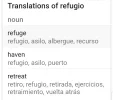The three most basic types of accommodation are the Refugio, the Hostel (not called that in Spanish), and the Albergue.
It's confusing that the three types blend into each other to a great degree with some rather wide grey zones.
A Refugio (Refuge) can be anything between a hut that you can lay down on the floor or on some very basic bedding (mattress or mattress on something like a metal frame) with no other comforts for your sleep other than what you're carrying on your back, so no running water nor anything else, and little or none of what many today would consider as the most basic accommodations with at least a proper bed and electrics and a shower room and someone at least basically responsible for the place and willing to help. (my first sleeping place last year after crossing into Spain over the Perthus was one of these, and they existed on the Francès back in the 90s)
(that's BTW a good step up from the absolute most basic indoor accommodations which involve garage floors, outside barns, abandoned wooden huts, and so on)
Hostels (sometimes called Hostals but more often Albergues in Spanish) are generally speaking the same as the above but with facilities so that you can cook your own food, or maybe located in the same building as a restaurant, and they provide a cheap but ordinarily acceptable place to sleep, plus better hot water and toilets. They're usually either quite tiny or they have the simplest bunk bed accommodation. Rather uncommon on the Francès, and they're located mostly nowadays on the minor Camino routes inside Spain else outside Spain altogether. They exist mostly in places with very few pilgrims passing through. Quite a few of them do provide facilities so you can make yourself some rudimentary breakfast in the morning, plus somebody who can help at least a little.
Albergues are the whole range between a basic Hostel and a basic Hotel. Bunk beds usually on the Francès, though you can from time to time come across individual beds or even bedrooms. They are anyway the most common type of pilgrim accommodation along the Francès nowadays. It is not uncommon that they will provide dinner for a price, as well as more often a breakfast. They vary in nature a lot more than the other two categories, so they are harder to define. But they do have in common that they try and provide at least some basic degree of comfort.
























